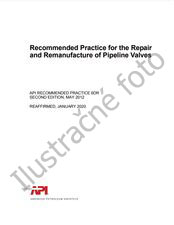Potrebujeme váš súhlas na využitie jednotlivých dát, aby sa vám okrem iného mohli ukazovať informácie týkajúce sa vašich záujmov. Súhlas udelíte kliknutím na tlačidlo „OK“.

API RP 932-B-ed.3
Design, Materials, Fabrication, Operation, and Inspection Guidelines for Corrosion Control in Hydroprocessing Reactor Effluent Air Cooler (REAC) Systems
NORMA vydaná dňa 1.6.2019
Informácie o norme:
Označenie normy: API RP 932-B-ed.3
Dátum vydania normy: 1.6.2019
Kód tovaru: NS-1140280
Počet strán: 70
Približná hmotnosť: 210 g (0.46 libier)
Krajina: Americká technická norma
Kategória: Technické normy API
Anotácia textu normy API RP 932-B-ed.3 :
API RP 932-B, 3rd Edition, June 2019 - Design, Materials, Fabrication, Operation, and Inspection Guidelines for Corrosion Control in Hydroprocessing Reactor Effluent Air Cooler (REAC) Systems
This recommended practice provides guidance to engineering and plant personnel on equipment and piping design, material selection, fabrication, operation, and inspection practices to manage corrosion and fouling in the wet sections of hydroprocessing reactor effluent systems. The reactor effluent system includes the equipment and piping subject to ammonium salting, NH4HS corrosion, and associated fouling. This system usually begins at the last feed/effluent exchanger or first water injection point and continues through the cold high-pressure separator (1, 2, and 3 separator designs) or cold high- and low-pressure separators (4 and 5 separator designs). The reactor effluent system specifically excludes the stripper, fractionator, and final separation sections. However, guidance in this document may be applicable to ammonium salt corrosion mitigation in those areas, as well. The majority of these systems have an air cooler; however, some systems utilize only shell and tube heat exchangers. Reactor effluent systems are prone to fouling and corrosion by ammonium bisulfide (NH4HS) and ammonium chloride (NH4Cl) salts.
An understanding of all variables impacting corrosion and fouling in these systems is necessary to improve the reliability, safety, and environmental impact associated with them. Past attempts to define generic optimum equipment design and acceptable operating variables to minimize fouling and corrosion have had limited success due to the interdependence of the variables. Corrosion can occur at high rates and be extremely localized, making it difficult to inspect for deterioration and to accurately predict remaining life of equipment and piping. Within the refining industry, continuing equipment replacements, unplanned outages, and catastrophic incidents illustrate the current need to better understand the corrosion characteristics and provide guidance on all factors that can impact fouling and corrosion.
This recommended practice is applicable to process streams in which NH4Cl and NH4HS salts can form and deposit in equipment and piping or dissolve in water to form aqueous solutions of these salts. Included in this practice are:
- — details of deterioration mechanisms;
- — methods to assess and monitor the corrosivity of systems;
- — details on materials selection, design, and fabrication of equipment for new and revamped processes;
- — considerations in equipment repairs; and
- — details of an inspection plan.
Table 1 lists factors affecting reactor effluent air cooler (REAC) system performance and section reference for more detail.
Materials and corrosion specialists should be consulted for additional unit-specific interpretation and application of this document. Each facility needs to establish its own safe operating envelope to ensure satisfactory service. This recommended practice helps to identify key variables necessary for monitoring and establishing the operating envelope.
Other equipment downstream of the REAC can also deteriorate from these ammonium salts. These include the recycle and sour gas systems and the H2S stripper and product fractionator overhead systems. Although these are beyond the scope of this document, plant personnel should be alert to these other locations where ammonium salt fouling and corrosion can occur.
Since the first edition of API 932-B was published in July 2004, findings from several joint industry sponsored research programs have contributed important new data on NH4HS corrosion relevant to these systems. While not all the data are in the public domain, recent publications have highlighted key data that are incorporated into this current edition of API 932-B.
Odporúčame:
Aktualizácia technických noriem
Chcete mať istotu, že používate len platné technické normy?
Ponúkame Vám riešenie, ktoré Vám zaistí mesačný prehľad o aktuálnosti noriem, ktoré používate.
Chcete vedieť viac informácií ? Pozrite sa na túto stránku.



 Cookies
Cookies
